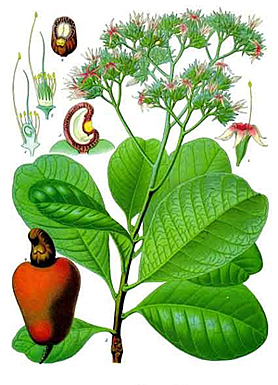
Interesting Facts...
 Humans were using spices
in 50,000 BC. The spice trade developed
throughout the Middle East in around 2000 BC with
cinnamon
and pepper, and in East Asia (Korea, China) with
herbs and
pepper.
Humans were using spices
in 50,000 BC. The spice trade developed
throughout the Middle East in around 2000 BC with
cinnamon
and pepper, and in East Asia (Korea, China) with
herbs and
pepper.
 In the 18th century, Holland had such a fiercely
guarded monopoly on the
clove
trade that the government made growing or selling
cloves
outside its colony of Amboina, in Indonesia, a crime
punishable by death. The Chinese were said to use
them as far back as 226 BC. Apparently they chewed
the flowerettes prior to having an audience with the
Emperor so that their breath would not smell bad.
In the 18th century, Holland had such a fiercely
guarded monopoly on the
clove
trade that the government made growing or selling
cloves
outside its colony of Amboina, in Indonesia, a crime
punishable by death. The Chinese were said to use
them as far back as 226 BC. Apparently they chewed
the flowerettes prior to having an audience with the
Emperor so that their breath would not smell bad.
 Cardamom is used to break up kidney stones and gallstones,
and was reportedly used as an antidote for both snake and
scorpion venom. Guatemala is the largest producer of cardamom
in the world with an average yield of between 25 thousand
to 29 thousand metric tons annually.
Cardamom is used to break up kidney stones and gallstones,
and was reportedly used as an antidote for both snake and
scorpion venom. Guatemala is the largest producer of cardamom
in the world with an average yield of between 25 thousand
to 29 thousand metric tons annually.
 Vanilla
is the only edible fruit of the orchid family,
the largest family of flowering plants in the world
Vanilla
is the only edible fruit of the orchid family,
the largest family of flowering plants in the world
 The early term for "merchant" in Austronesian is *dagang
(Dempwolff) and this word is very similar to one of
the terms for "ocean."
The early term for "merchant" in Austronesian is *dagang
(Dempwolff) and this word is very similar to one of
the terms for "ocean."
 Columbus' far-fetched proposal to reach the East
Indies by sailing westward received the support of
the Spanish crown, which saw in it a promise,
however remote, of gaining the upper hand over rival
powers in the contest for the lucrative spice trade
with Asia
Columbus' far-fetched proposal to reach the East
Indies by sailing westward received the support of
the Spanish crown, which saw in it a promise,
however remote, of gaining the upper hand over rival
powers in the contest for the lucrative spice trade
with Asia
 The Cashew Nut is actually a seed and not a "nut",
in the botanical sense. The seed is surrounded
by a double shell containing an allergenic phenolic
resin, anacardic acid, a potent skin irritant
chemically related to the more well known allergenic
oil urushiol which is also a toxin found in the
related poison ivy. Properly roasting cashews
destroys the toxin, but it must be done outdoors as
the smoke (not unlike that from burning poison ivy)
contains urushiol droplets which can cause severe,
sometimes life-threatening, reactions by irritating
the lungs.
The Cashew Nut is actually a seed and not a "nut",
in the botanical sense. The seed is surrounded
by a double shell containing an allergenic phenolic
resin, anacardic acid, a potent skin irritant
chemically related to the more well known allergenic
oil urushiol which is also a toxin found in the
related poison ivy. Properly roasting cashews
destroys the toxin, but it must be done outdoors as
the smoke (not unlike that from burning poison ivy)
contains urushiol droplets which can cause severe,
sometimes life-threatening, reactions by irritating
the lungs.
 While native to Brazil, the
Portuguese took the
cashew
plant to Goa, India, between the years of 1560
and 1565. From there it spread throughout Southeast
Asia and eventually Africa.
While native to Brazil, the
Portuguese took the
cashew
plant to Goa, India, between the years of 1560
and 1565. From there it spread throughout Southeast
Asia and eventually Africa.


 |
 
Raw Cashew Nuts
The cashew is a tree in the family
Anacardiaceae. Its English name derives from the
Portuguese name for the fruit of the cashew tree,
caju, which in turn derives from the indigenous Tupi
name, acajú. Raw cashew is now widely grown in tropical
climates for its cashew nuts and cashew apples.
Cashew nuts are actually the
kidney-shaped seeds that adhere to the bottom of the
cashew apple, the fruit of the cashew tree.
The tree is small and
evergreen, growing to 10-12m (~32 ft) tall, with a
short, often irregularly shaped trunk. The leaves
are spirally arranged, leathery textured, elliptic
to obovate, 4 to 22 cm long and 2 to 15 cm broad,
with a smooth margin.

Cashew Tree displaying the
Cashew Apple, Raw Cashew Nut and Cashew kernel
Source:
http://pharm1.pharmazie.uni-greifswald.de/allgemei/koehler/koeh-eng.htm
The cashew apple
“fruit” is not really a fruit, but an enlarged
fleshy stem that produces the seed. The flesh has
the consistency of a mango, and the flavor is
somewhat similar in taste
Kautilya Commodities
is a supplier of cashew nuts from Madagascar
For further
information about our Raw Cashew nuts like availability,
specifications, price, please
contact us
now.
Home

Raw Cashew Nuts
|















